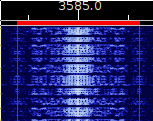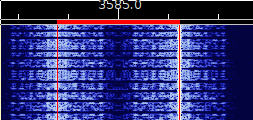
FeldHell
Spectrum
Sound

FskHell
Spectrum
Sound

FeldHell Spectrum Sound |

FskHell Spectrum Sound |
The name Hellschreiber means 'Hell's writer'. The technique was developed by Rudolf Hell in 1927, and was used as a successful radio mode first in 1937, well before RTTY. Use by Amateurs is relatively recent. The most popular mode is that used by the war-time Feld-Hellschreiber (field writer), which is on-off keyed, the same as Morse. In order to limit the bandwidth, the rise-time of dots is usually limited to about 1ms, and the best methods use raised cosine shaped dots.
FSK-Hell, of recent invention, uses differential Minimum Shift Keying (2-MSK) with a raised cosine envelope to minimize bandwidth. The technique is similar to PSK with one tone suppressed. These modes are much more sensitive than all other Hell modes, and have much better resistance to multi-path and Doppler. Of all Hell modes, only FSK-Hell 245 can correctly use a regular computer font. The FSK-Hell 105 version uses a special restricted resolution font to achieve very narrow bandwidth. Great for DX!
The Hell 80 mode is a Hell original from the 1970s. It is a rival to RTTY, with similar speed and bandwidth.
All Hellschreiber modes are based on character scanning, reproducing characters in a similar way to a dot-matrix printer. This technique uses a digital transmission, yet allows the received result to be interpreted by eye, a similar concept to the reception of Morse by ear. The character is scanned upwards, then left to right. There are typically 14 pixels (transmitted dot elements) per column (although single pixels are never transmitted) and up to seven columns per character including inter-character space.
These remarkably simple modes are easy to use, easy to tune, and although not especially sensitive, are entirely suited to HF since they use no sync and the eye can discern the text even in high levels of noise.
These are unconnected, manual quasi-synchronous scanned image simplex chat modes, using high redundancy instead of error correction. The receiver presents a grey-scale view of the raw received signal. The default calling mode is Feld-Hell (122.5 baud).
There is no coding. The character is scanned and transmitted as sequential pixels. An upper-case only character set is usually used, and a special font developed by Hell gives improved readability and cleverly limits the bandwidth. Most recent systems use proportional character spacing to improve speed. The modulation technique depends on the mode.
| Mode | Symbol Rate | Typing Speed1 | Duty Cycle2 | Modulation | Bandwidth3 | ITU Designation4 |
| Feld-Hell5 | 122.5 baud | ~ 2.5 cps (25 wpm) | ~ 22% | OOK ASK | 350 Hz | 350HA1B |
| Slow Hell | 14 baud | ~ 0.28 cps (2.8 wpm) | ~ 22% | OOK ASK | 40 Hz | 40H0A1B |
| Feld-Hell X5 | 612.5 baud | ~ 12.5 cps (125 wpm) | ~ 22% | OOK ASK | 1750 Hz | 1K75A1B |
| Feld-Hell X9 | 1102.5 baud | ~ 22.5 cps (225 wpm) | ~ 22% | OOK ASK | 3150 Hz | 3K15A1B |
| FSK-Hell 245 | 245 baud | ~ 2.5 cps (25 wpm) | ~ 80% | 2-MSK6 | 490 Hz | 490HF1B |
| FSK-Hell 105 | 105 baud | ~ 2.5 cps (25 wpm) | ~ 80% | 2-MSK6 | 210 Hz | 210HF1B |
| Hell 80 | 245 baud | ~ 5.0 cps (50 wpm) | 100% | 2-FSK (480Hz) | 800 Hz | 800HF1B |
1. WPM is based on an average 5 characters per word, plus word
space. Values are approximate because a proportional or small font
increases speed.
2. Transmitter average power output relative to a constant carrier
of the same PEP value.
3. This is the "Necessary Bandwidth" as defined by the ITU.
4. A summary of the ITU Designation system can be found at